Recent Commercial Posts
Water Damage Can Hold Your Business Back
11/5/2024 (Permalink)
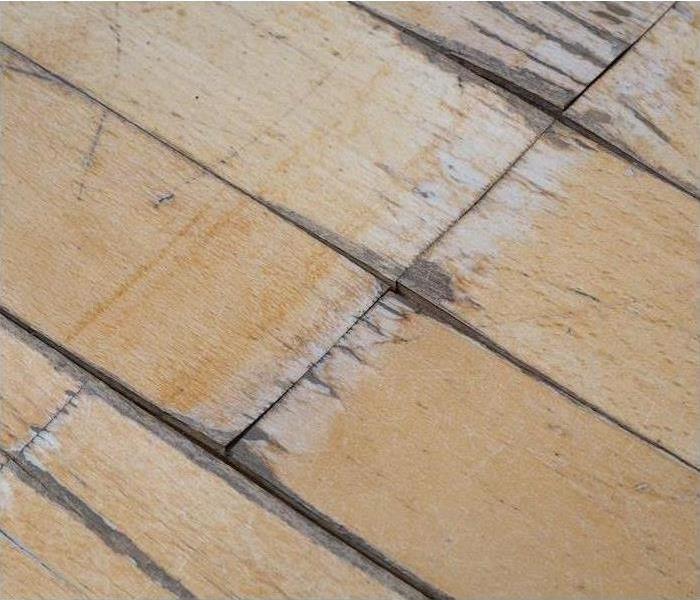 SERVPRO of Billings is your local commercial restoration company. We will always be here to help clean up and get you back in business.
SERVPRO of Billings is your local commercial restoration company. We will always be here to help clean up and get you back in business.
A water intrusion in your commercial building can be devastating for business.
Flooding can start inside due to a plumbing issue or a leaky roof that results in lost inventory, closed-off floors or even the need to shut down for a while.
Natural causes of flooding are also a huge area of concern, too. Yellowstone River is a consistent source of flooding, just as the rainy season and snowmelt season are.
With so many risk factors for our area, it is essential to know what to do before flooding happens so that you can prevent and protect your business as much as possible. The more you are able to do before a disaster, the faster and safer you will bounce back afterwards.
Know Your Building’s Layout
One of the first steps you should take to prevent extensive damages to your property is learning the layout of your building. Find the shutoffs for the sprinkler system and the main water line so that you can turn water off quickly in the event of a failure or a leak.
Educate your staff or the businesses that rent your space with this information and make sure there are designated people in your emergency plan to handle shutting water off as needed.
Know the Types of Water Involved
If you do experience a flood or leak, understanding the kind of water you are dealing with is crucial in keeping everyone in your building safe.
White water. This is a common kind of water intrusion and typically originates from plumbing. This water is not considered contaminated and can be handled on your own when it is in small amounts.
Gray water. Gray water comes from sinks or toilets when they overflow. While this water is considered contaminated, it is not dangerous.
Black water. Flooding from storms or a sewage backup are considered black water, a form of flooding that is toxic and requires a professional cleanup response.
Take Action Quickly
Timing will always matter when it comes to water damage, so the sooner you can locate the source of water and shut it down, the better.
Once you have the initial water flow stopped, open windows and doors to get as much air flowing as possible. Let everyone in the building know to avoid the area.
Take pictures and note damaged areas as much as you are able to ease your insurance claim process. This documentation can also serve as indicators for where your building may need to be shored up during the restoration process.
Remember to Be Patient
Water damage is harder to see than you may think. Once the initial area is dry, there may be hidden damages such as wet wall studs, moldy framing and buckled floors. Keep an eye out for these signs of deep damages so you can address any issues quickly.
After water does intrude, call SERVPRO of Billings as quickly as possible. We will create a plan and walk with you through the entire process of drying out and restoring your business.
Sanitation and drying can take up to a week or more depending on the severity of the flooding, so stay patient throughout the process.
Our team has the experience, training and equipment to get your business up and running as fast as possible. We will have you back to normal before you could even imagine.
When disaster strikes your commercial property, we’ll be there to help clean up and get you back in business quickly. Reach out 24⁄7 to get started!
Why Should You Choose SERVPRO for Water Restoration Projects
9/10/2024 (Permalink)
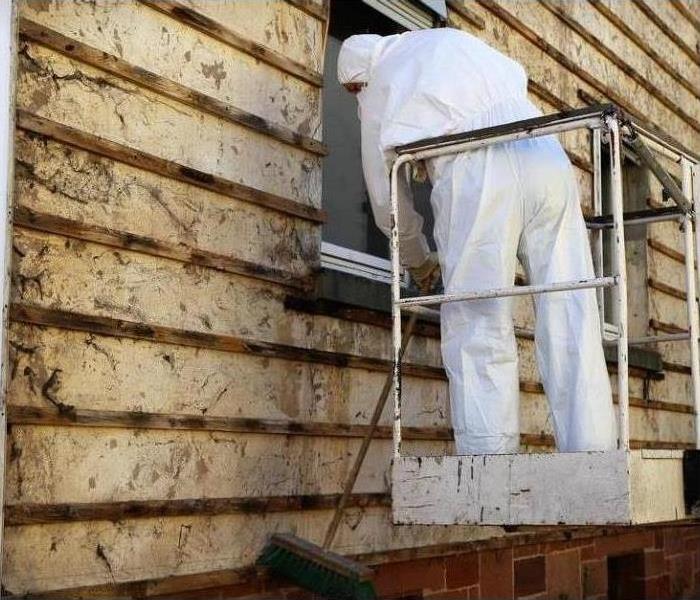 Our Team is Ready to Help! Call Us at (406)252-0859
Our Team is Ready to Help! Call Us at (406)252-0859
Here are the typical steps involved in the water restoration and mitigation process performed by SERVPRO of Billings:
- Inspection and Assessment: Professionals from SERVPRO of Billings will assess the extent of the water damage and identify the source of the problem.
- Water Removal: The team will use specialized equipment to extract standing water from the affected area. This step helps prevent further damage and reduces the drying time.
- Drying and Dehumidification: SERVPRO of Billings uses industrial-grade fans and dehumidifiers to remove any remaining moisture from surfaces and the air. This prevents mold growth and further structural damage.
- Cleaning and Sanitizing: The professionals will clean and sanitize all affected areas and belongings. This includes removing soor, smoke odor, and any contaminants that may have been present due to fire.
- Restoration and Repairs: Once the cleanup process is complete SERVPRO of Billings can take care of restoring and repairing any damaged structures or belongings. This can involve minor repairs or more extensive renovations, depending on the extent of the damage.
SERVPRO of Billings aims to provide comprehensive services to ensure a smoother and more efficient restoration process after a fire or water damage event.
Choosing a one-stop-shop like SERVPRO of Billings can indeed be beneficial as it saves time and effort in coordinating multiple vendors for different services. Additionally, having one company handle all aspects of restoration can potentially result in cost savings.
If many insurance companies have already chosen SERVPRO of Billings as their preferred vendor, it may indicate that they have a good reputation and track record in the industry.
Ultimately, it is important to evaluate and compare various restoration companies based on their services, reputation, and customer reviews to make an informed decision that best suits your specific needs.
Fire Extinguisher Basics for Your Business
4/23/2024 (Permalink)
 Dealing with the aftermath of a commercial fire? Our SERVPRO specialists can restore your losses and return your workplace to its pre-fire condition.
Dealing with the aftermath of a commercial fire? Our SERVPRO specialists can restore your losses and return your workplace to its pre-fire condition.
You may not want to imagine an emergency occurring at work, but when you are not prepared for one, it can make the situation much worse. If a fire were to break out in your commercial building, you would want the reassuring knowledge that you and your crew know how to properly respond.
Starting with the basics of fire safety, including what to do with a fire extinguisher, is a great way to create policies and procedures for your building in the event of an emergency. Fire extinguishers do not take a lot of training to learn, but they are not innately known by very many either.
Train your staff in the fundamentals of fire safety, and rest easier knowing your property is protected.
Start With the Fundamentals
When you manage or own commercial property, it is crucial to ensure you have the right safety equipment in the right places. OSHA rules make it plain that any building that has a fire extinguisher must have someone trained to properly handle it.
That means it is your job to train your crew on not only how to use a fire extinguisher, but also on the different varieties of extinguishers.
Make the first part of your training be how to hold and aim an extinguisher. Instruct your employees to first get a solid grasp and direction, then to pull the pin and squeeze the trigger. Flames should be extinguished in a sweeping motion in order to cover a large area at once. Make sure your team knows to stand six to eight feet away from a fire in order to protect themselves from burns.
PASS is a great acronym that can be used to help your staff remember the basic steps if they do ever grab an extinguisher. Review the basics at least once a year with anyone that could potentially be present during an event, even if someone has been around a long time.
As you set your basic training up, you may also want to create more individualized trainings and assign particular staff members to certain areas of your building. This can ensure that every part of your property is covered during an emergency, and every kind of extinguisher has someone prepared to use it.
There’s a Time and a Place
An important part of creating your training plan should be including information on the specific threats your building could see.
If you work with flammable materials in a warehouse setting, training for the kind of extinguisher and how to respond to those particular flames is crucial. If you have a kitchen in your building, make sure your employees understand the difference between a grease fire and a fire started by a different source, along with how to respond to each.
Understanding when it is safe to use a fire extinguisher and when it is not is also essential training for every member of your team. While quick action with an extinguisher can save lives and property, sometimes it is better to leave the area. Fire can spread quickly, and the safety of your staff should always be top priority.
If a situation has become overwhelming, make sure exit paths are clearly marked and employees know how to get out.
The better your workplace fire safety plan is the more you can mitigate the possibility of a disaster. Make sure everyone knows the fundamentals, and practice for every emergency situation in order to ensure the best possible outcomes every time.
If you have experienced fire damage or want to learn more about our fire damage restoration services, contact us today. We’re here to act fast, 24⁄7
Common Causes of Water Damage in Commercial Building | SERVPRO of Billings
3/5/2024 (Permalink)
 Experienced water damage in your commercial building? SERVPRO of Billings can help you get dried out quickly.
Experienced water damage in your commercial building? SERVPRO of Billings can help you get dried out quickly.
Water is one of the most common culprits when buildings are damaged, and even something as simple as a leaky toilet can leave behind an incredible amount of destruction.
When you own or operate a commercial building, catching every little drip or plumbing concern can be tricky. That’s why the more you learn about the most common causes of water damage, the more proactive you can be at preventing a total disaster.
3 Common Sources
There is no such thing as a good business interruption. Having to shut your doors because of a water disaster can not only cost you the loss of operating hours, but may also lead to thousands of dollars in needed repairs.
Make a habit of regularly checking these locations or having your maintenance crew do so in order to stop minor issues before they leave behind extensive damages:
- The roof. Roof leaks can happen all the sudden after a major storm, or could be the result of a slow leak. This kind of water damage can make its way from the top of your building to the bottom if left unchecked. Keep your gutters cleared and have your roof checked for missing shingles and other damage after every major wind or ice event.
- Bathrooms. Toilets and sink pipes can leak from a hole the size of a pinhead and account for nearly 15% of water loss in commercial buildings. If you have a large building, assign multiple staff members the task of checking pipes once a month or more to stop leaks before they become severe.
- Water heaters/HVAC/boilers. Any appliance that has a water line has the potential to leak, often as a result of clogged drains or loose pipe connections. Watch for puddles near your heating and cooling units, and keep an eye on your building’s water pressure. These are all indicators of a problem that can be stopped before your building is damaged.
Take Preventive Steps
Aside from a natural disaster that causes floodwaters to rush in, most water damage can be prevented when it is handled quickly. When you take the time to prepare, you can cut your losses dramatically.
Creating a maintenance plan is a great first step in ensuring your building avoids damage from plumbing or other pipes. Working with SERVPRO to create an Emergency Ready Plan for your business can help take the guesswork out of what to do when a water disaster strikes.
From there, you can also take other actions. Check fixtures and seals often, and train several people that access your building on how to shut off water in the event of an emergency.
Timing will always matter when it comes to controlling water damages. Respond to the immediate situation as quickly as possible, and then call us at SERVPRO of Billings. We can take your call day or night and start your restoration project right away so you can keep your business going.
Experienced water damage in your commercial building? Contact us to get dried out quickly.
Water Damage Can Hold Your Business Back | SERVPRO®
11/7/2023 (Permalink)
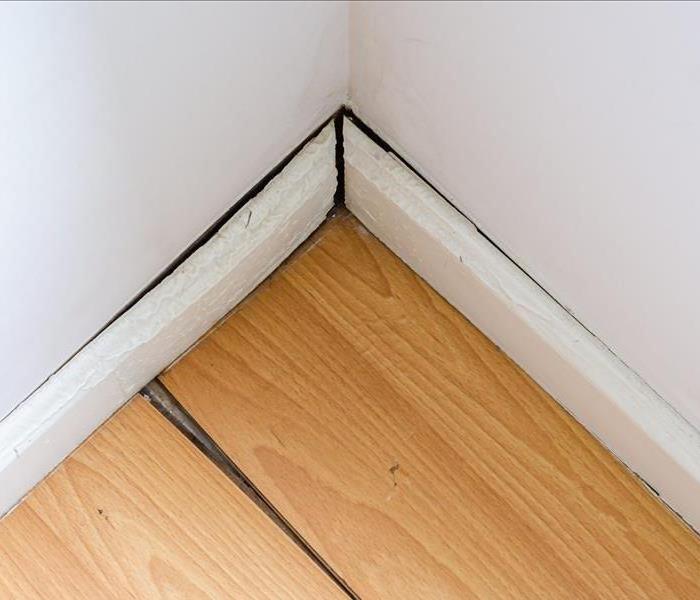 SERVPRO of Billings is your local commercial restoration company. We will always be here to help clean up and get you back in business.
SERVPRO of Billings is your local commercial restoration company. We will always be here to help clean up and get you back in business.
A water intrusion in your commercial building can be devastating for business.
Flooding can start inside due to a plumbing issue or a leaky roof that results in lost inventory, closed-off floors or even the need to shut down for a while.
Natural causes of flooding are also a huge area of concern, too. Yellowstone River is a consistent source of flooding, just as the rainy season and snowmelt season are.
With so many risk factors for our area, it is essential to know what to do before flooding happens so that you can prevent and protect your business as much as possible. The more you are able to do before a disaster, the faster and safer you will bounce back afterwards.
<h2your-building-s-layout">Know Your Building’s Layout
One of the first steps you should take to prevent extensive damages to your property is learning the layout of your building. Find the shutoffs for the sprinkler system and the main water line so that you can turn water off quickly in the event of a failure or a leak.
Educate your staff or the businesses that rent your space with this information and make sure there are designated people in your emergency plan to handle shutting water off as needed.
<h2the-types-of-water-involved">Know the Types of Water Involved
If you do experience a flood or leak, understanding the kind of water you are dealing with is crucial in keeping everyone in your building safe.
White water. This is a common kind of water intrusion and typically originates from plumbing. This water is not considered contaminated and can be handled on your own when it is in small amounts.
Gray water. Gray water comes from sinks or toilets when they overflow. While this water is considered contaminated, it is not dangerous.
Black water. Flooding from storms or a sewage backup are considered black water, a form of flooding that is toxic and requires a professional cleanup response.
<h2action-quickly">Take Action Quickly
Timing will always matter when it comes to water damage, so the sooner you can locate the source of water and shut it down, the better.
Once you have the initial water flow stopped, open windows and doors to get as much air flowing as possible. Let everyone in the building know to avoid the area.
Take pictures and note damaged areas as much as you are able to ease your insurance claim process. This documentation can also serve as indicators for where your building may need to be shored up during the restoration process.
<h2to-be-patient">Remember to Be Patient
Water damage is harder to see than you may think. Once the initial area is dry, there may be hidden damages such as wet wall studs, moldy framing and buckled floors. Keep an eye out for these signs of deep damages so you can address any issues quickly.
After water does intrude, call SERVPRO of Billings as quickly as possible. We will create a plan and walk with you through the entire process of drying out and restoring your business.
Sanitation and drying can take up to a week or more depending on the severity of the flooding, so stay patient throughout the process.
Our team has the experience, training and equipment to get your business up and running as fast as possible. We will have you back to normal before you could even imagine.
When disaster strikes your commercial property, we’ll be there to help clean up and get you back in business quickly. Reach out 24⁄7 to get started!
Water Damage in a Commercial Property | SERVPRO® of Billings
8/21/2023 (Permalink)
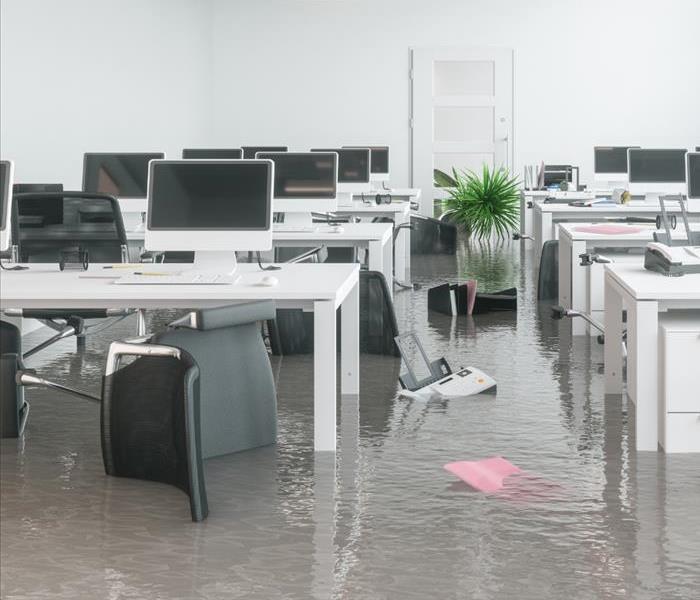 Does your commercial building have water damage? Let SERVPRO of Billings help you now.
Does your commercial building have water damage? Let SERVPRO of Billings help you now.
When facing water damage or flooding in a commercial property, it is crucial to take immediate action to minimize further damage and ensure the safety of the building and its occupants. Here are some important steps to consider:
- Safety first: Ensure that everyone in the building is safe and away from any potential hazards.
- Shut off the water source: If possible, identify and shut off the source of water to prevent any additional flooding.
- Call Professionals: Contact a licensed team of experts who specialize in commercial water damage restoration. They will have the knowledge and equipment to handle the situation effectively.
- Assess the damage: The professionals will evaluate the extent of the water damage and identify affected areas within the facility. This assessment will help determine the scope of repairs and restoration required.
- Water Removal: The team will use specialized equipment such as pumps, vacuums, and dehumidifiers to remove excess water from the affected areas.
- Dry and dehumidify: Proper drying and dehumidification techniques are essential to prevent mold growth and further damage. The team will use industrial-grade air movers and dehumidifiers to remove moisture from the air and surfaces.
- Salvage and cleaning: Salvage any salvageable items and remove damaged components such as carpets, drywall, insulation, or furniture. The team will clean and sanitize the affected areas to prevent mold growth and ensure a safe environment.
- Repairs and restoration: Once the affected areas are dry, repairs and restoration work can begin. This may involve replacing damaged materials, repairing structural components, and restoring the aesthetics of the building.
- Mold and microbial inspection: It is crucial to have a mold and microbial inspection conducted by professionals to ensure the long-term health of both the building and occupants. This inspection will identify any potential mold or microbial growth and provide recommendations for remediation if necessary.
- Insurance: Contact your insurance provider as soon as possible to report the incident and initiate the claims process. Provide them with all necessary documentation and information to expedite the process.
Remember, acting quickly and engaging professionals with experience in commercial water damage restoration is essential to minimize the damage and ensure a safe and healthy environment for everyone in the building.
Fire Extinguisher Basics for Your Business | SERVPRO® of Billings
4/3/2023 (Permalink)
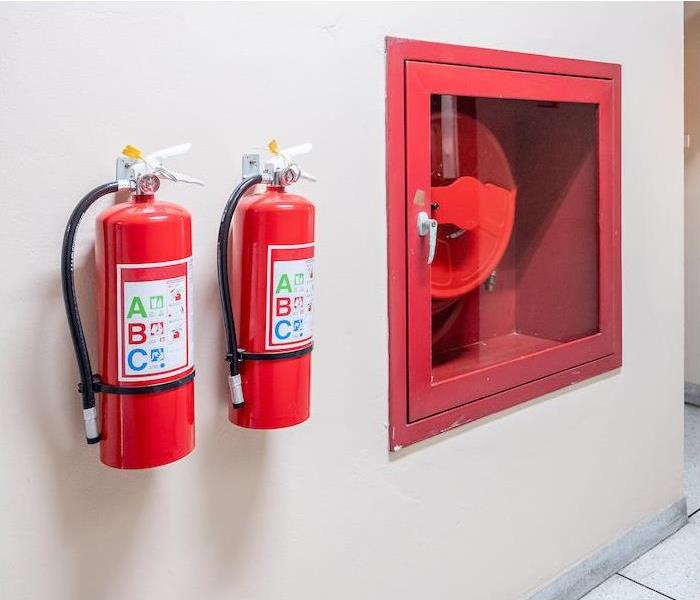 Dealing with the aftermath of a commercial fire? Our SERVPRO specialists can restore your losses and return your workplace to its pre-fire condition.
Dealing with the aftermath of a commercial fire? Our SERVPRO specialists can restore your losses and return your workplace to its pre-fire condition.
You may not want to imagine an emergency occurring at work, but when you are not prepared for one, it can make the situation much worse. If a fire were to break out in your commercial building, you would want the reassuring knowledge that you and your crew know how to properly respond.
Starting with the basics of fire safety, including what to do with a fire extinguisher, is a great way to create policies and procedures for your building in the event of an emergency. Fire extinguishers do not take a lot of training to learn, but they are not innately known by very many either.
Train your staff in the fundamentals of fire safety, and rest easier knowing your property is protected.
<h2with-the-fundamentals">Start With the Fundamentals
When you manage or own commercial property, it is crucial to ensure you have the right safety equipment in the right places. OSHA rules make it plain that any building that has a fire extinguisher must have someone trained to properly handle it.
That means it is your job to train your crew on not only how to use a fire extinguisher, but also on the different varieties of extinguishers.
Make the first part of your training be how to hold and aim an extinguisher. Instruct your employees to first get a solid grasp and direction, then to pull the pin and squeeze the trigger. Flames should be extinguished in a sweeping motion in order to cover a large area at once. Make sure your team knows to stand six to eight feet away from a fire in order to protect themselves from burns.
PASS is a great acronym that can be used to help your staff remember the basic steps if they do ever grab an extinguisher. Review the basics at least once a year with anyone that could potentially be present during an event, even if someone has been around a long time.
As you set your basic training up, you may also want to create more individualized trainings and assign particular staff members to certain areas of your building. This can ensure that every part of your property is covered during an emergency, and every kind of extinguisher has someone prepared to use it.
<h2s-a-time-and-a-place">There’s a Time and a Place
An important part of creating your training plan should be including information on the specific threats your building could see.
If you work with flammable materials in a warehouse setting, training for the kind of extinguisher and how to respond to those particular flames is crucial. If you have a kitchen in your building, make sure your employees understand the difference between a grease fire and a fire started by a different source, along with how to respond to each.
Understanding when it is safe to use a fire extinguisher and when it is not is also essential training for every member of your team. While quick action with an extinguisher can save lives and property, sometimes it is better to leave the area. Fire can spread quickly, and the safety of your staff should always be top priority.
If a situation has become overwhelming, make sure exit paths are clearly marked and employees know how to get out.
The better your workplace fire safety plan is the more you can mitigate the possibility of a disaster. Make sure everyone knows the fundamentals, and practice for every emergency situation in order to ensure the best possible outcomes every time.
If you have experienced fire damage or want to learn more about our fire damage restoration services, contact us today. We’re here to act fast, 24⁄7
Common Causes of Water Damage in Commercial Building | SERVPRO® of Billings
2/28/2023 (Permalink)
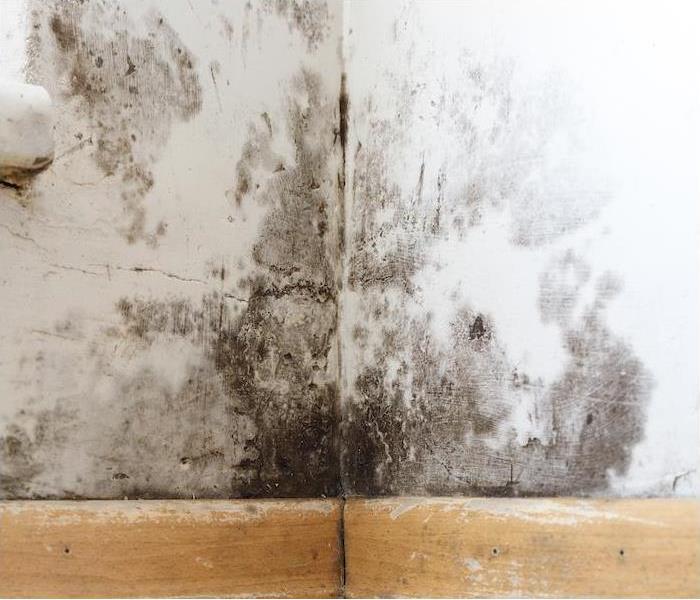 Experienced water damage in your commercial building? SERVPRO of Billings can help you get dried out quickly.
Experienced water damage in your commercial building? SERVPRO of Billings can help you get dried out quickly.
Water is one of the most common culprits when buildings are damaged, and even something as simple as a leaky toilet can leave behind an incredible amount of destruction.
When you own or operate a commercial building, catching every little drip or plumbing concern can be tricky. That’s why the more you learn about the most common causes of water damage, the more proactive you can be at preventing a total disaster.
3 Common SourcesThere is no such thing as a good business interruption. Having to shut your doors because of a water disaster can not only cost you the loss of operating hours, but may also lead to thousands of dollars in needed repairs.
Make a habit of regularly checking these locations or having your maintenance crew do so in order to stop minor issues before they leave behind extensive damages:
1. The roof. Roof leaks can happen all the sudden after a major storm, or could be the result of a slow leak. This kind of water damage can make its way from the top of your building to the bottom if left unchecked. Keep your gutters cleared and have your roof checked for missing shingles and other damage after every major wind or ice event.
2. Bathrooms. Toilets and sink pipes can leak from a hole the size of a pinhead and account for nearly 15% of water loss in commercial buildings. If you have a large building, assign multiple staff members the task of checking pipes once a month or more to stop leaks before they become severe.
3. Water heaters/HVAC/boilers. Any appliance that has a water line has the potential to leak, often as a result of clogged drains or loose pipe connections. Watch for puddles near your heating and cooling units, and keep an eye on your building’s water pressure. These are all indicators of a problem that can be stopped before your building is damaged.
Take Preventive StepsAside from a natural disaster that causes floodwaters to rush in, most water damage can be prevented when it is handled quickly. When you take the time to prepare, you can cut your losses dramatically.
Creating a maintenance plan is a great first step in ensuring your building avoids damage from plumbing or other pipes. Working with SERVPRO to create an Emergency Ready Plan for your business can help take the guesswork out of what to do when a water disaster strikes.
From there, you can also take other actions. Check fixtures and seals often, and train several people that access your building on how to shut off water in the event of an emergency.
Timing will always matter when it comes to controlling water damages. Respond to the immediate situation as quickly as possible, and then call us at SERVPRO. We can take your call day or night and start your restoration project right away so you can keep your business going.
Experienced water damage in your commercial building? Contact us to get dried out quickly.
Water Damage Can Hold Your Business Back | SERVPRO® of Billings
10/25/2022 (Permalink)
 SERVPRO of Billings is your local commercial restoration company. We will always be here to help clean up and get you back in business.
SERVPRO of Billings is your local commercial restoration company. We will always be here to help clean up and get you back in business.
A water intrusion in your commercial building can be devastating for business.
Flooding can start inside due to a plumbing issue or a leaky roof that results in lost inventory, closed-off floors or even the need to shut down for a while.
Natural causes of flooding are also a huge area of concern, too. Yellowstone River is a consistent source of flooding, just as the rainy season and snowmelt season are.
With so many risk factors for our area, it is essential to know what to do before flooding happens so that you can prevent and protect your business as much as possible. The more you are able to do before a disaster, the faster and safer you will bounce back afterwards.
Know Your Building’s LayoutOne of the first steps you should take to prevent extensive damages to your property is learning the layout of your building. Find the shutoffs for the sprinkler system and the main water line so that you can turn water off quickly in the event of a failure or a leak.
Educate your staff or the businesses that rent your space with this information and make sure there are designated people in your emergency plan to handle shutting water off as needed.
Know the Types of Water InvolvedIf you do experience a flood or leak, understanding the kind of water you are dealing with is crucial in keeping everyone in your building safe.
White water. This is a common kind of water intrusion and typically originates from plumbing. This water is not considered contaminated and can be handled on your own when it is in small amounts.
Gray water. Gray water comes from sinks or toilets when they overflow. While this water is considered contaminated, it is not dangerous.
Black water. Flooding from storms or a sewage backup are considered black water, a form of flooding that is toxic and requires a professional cleanup response.
Take Action QuicklyTiming will always matter when it comes to water damage, so the sooner you can locate the source of water and shut it down, the better.
Once you have the initial water flow stopped, open windows and doors to get as much air flowing as possible. Let everyone in the building know to avoid the area.
Take pictures and note damaged areas as much as you are able to ease your insurance claim process. This documentation can also serve as indicators for where your building may need to be shored up during the restoration process.
Remember to Be PatientWater damage is harder to see than you may think. Once the initial area is dry, there may be hidden damages such as wet wall studs, moldy framing and buckled floors. Keep an eye out for these signs of deep damages so you can address any issues quickly.
After water does intrude, call SERVPRO of Billings as quickly as possible. We will create a plan and walk with you through the entire process of drying out and restoring your business.
Sanitation and drying can take up to a week or more depending on the severity of the flooding, so stay patient throughout the process.
Our team has the experience, training and equipment to get your business up and running as fast as possible. We will have you back to normal before you could even imagine.
When disaster strikes your commercial property, we’ll be there to help clean up and get you back in business quickly. Reach out 24⁄7 to get started!
Preparedness Planning for Your Commercial Business
8/2/2022 (Permalink)
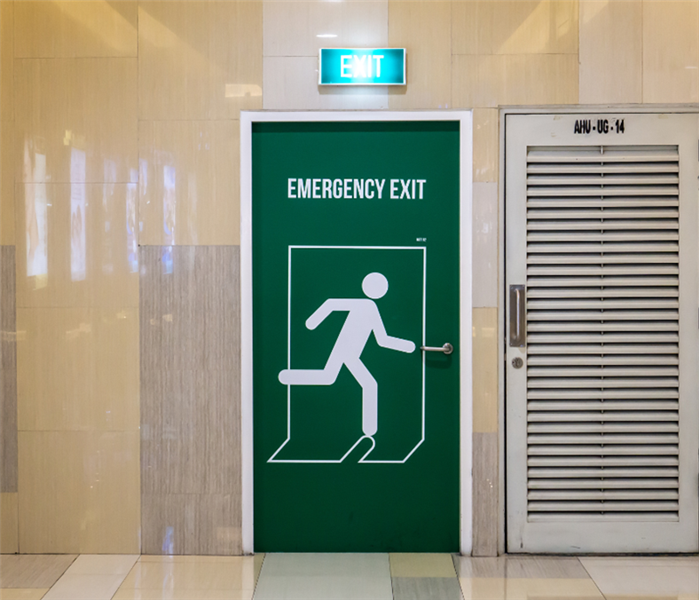 How quickly your company can get back to business after a storm, fire, or flood often depends on the emergency planning done today.
How quickly your company can get back to business after a storm, fire, or flood often depends on the emergency planning done today.
How quickly your company can get back to business after a storm, fire, or flood often depends on the emergency planning done today. The regular occurrence of natural disasters demonstrates the importance of being prepared for any emergency. While each situation is unique, your organization can be better prepared if you plan carefully, put emergency procedures in place, and practice for all kinds of emergencies.
The following are common sense measures business owners and managers can take to start getting ready. A commitment to begin planning today will help support your employees, customers and the community. It also protects your business investment and gives your company a better chance for survival.
Review the following questions to learn if your company is prepared.
Be Informed
Do you know what kind of emergencies might affect your company?
Do you know what you
will do in an emergency situation?
Develop a Business Continuity Plan
Do you know which staff, procedures, and equipment are absolutely necessary to keep operating?
Do you have backup plans for those operations?
Do you know what you will do if your building or plant is not accessible?
Do you know what you will do if your
suppliers are impacted by a disaster?
Are you ready for utility disruptions?
Prepare Your Emergency Plan
Do you have an evacuation and shelter-in-place plan?
Do you have a plan to communicate with employees before, during, and after an incident?
Do you have copies of building and site maps with utilities and emergency routes marked?
Are your employees trained for medical emergencies?
Practice the Emergency Plan
Have you practiced your plan recently?
Do you practice and coordinate with other businesses in your building or industrial complex?
Have you reviewed your plans in the last 12 months?
Review Insurance Coverage
Have you reviewed your insurance coverage recently to see if you’re covered in a disaster?
Secure Your Facility and Equipment
Have you secured all the ways people, products, and supplies get into your building?
Have you conducted a room-by-room walk-through to determine what can be strapped down?
Improve Cyber-security
Do you regularly install patches to your software?
Have you installed a firewall on your computer?
Do you regularly update your antivirus software?
Promote Family and Individual Preparedness
Do you encourage employees to have a personal emergency supply kit and a family communication plan?
If you answered “No” to any of these questions, visit ready.gov and learn how to better prepare your business.
The Top Causes of Commercial Damage | SERVPRO® of Billings
6/17/2022 (Permalink)
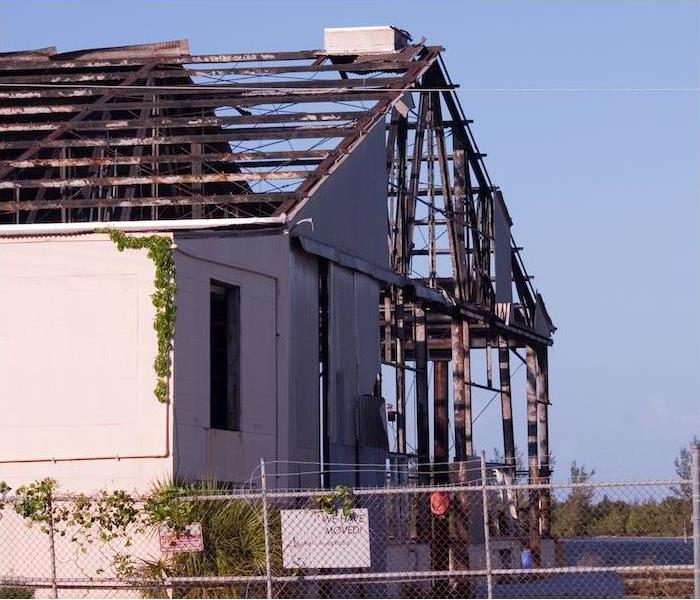 SERVPRO of Billings is your local commercial disaster team. Contact us to learn more about our commercial damage restoration services.
SERVPRO of Billings is your local commercial disaster team. Contact us to learn more about our commercial damage restoration services.
Businesses make our country thrive. It’s likely you don’t often go a day without utilizing a business of some sort.
When you own a business, you have a lot on your plate simply managing the day-to-day, and when a disaster strikes, it can be completely devastating.
Damage caused by natural disasters has been increasing steadily recently in the United States. Over the last five years, our country has experienced close to $153 billion worth of damage annually, which is substantially higher than previous periods.
Living in Montana means that we can face a variety of extreme weather, with the top two natural disasters stemming from wildfires and flooding. It is also well-known that Billings is cold and receives high amounts of snow each long winter.
Tornadoes and severe thunderstorms are also possible in our neighborhoods. While this year’s snowpack is on track to fulfill our water supply with minimal potential for flooding, we all know well that as the weather warms up, snow melt and heavy rains can quickly spell disaster. This fine line means that we need to be ready to handle anything that Mother Nature brings our way.
The more we learn about the potential disasters our businesses could face, the better we can prepare.
Water DamageWater is one of the top causes of damage to businesses around the country. This can stem from severe weather or something internal like an appliance failure, and either way, it can cause extreme damage to your property.
Exterior flooding from excessive rains or overflowing rivers can seep through floors and the seals on your doors, which can lead to damage to your foundation. If the exterior of your building allows it, landscaping can be strategically placed to divert water away from your building as a preventive measure. This is especially essential in our towns when snow and ice begin to melt.
Damage can also occur from interior sources when a leak is allowed to drip for an extended amount of time. Plumbing in your building should be regularly checked for signs of water damage, including warping and discoloration on the walls and flooring.
When you stay on top of routine maintenance now, you can prevent costly repairs later.
Storm DamageDestruction from storms is be very common for commercial properties and can devastate an entire section of businesses or rip only a single roof tile, seemingly at random. Even a power outage or downed trees can cause an unwelcome disruption and keep you away from work longer than you want.
A powerful storm can rip off a roof or cause structural damage that could be irreversible. These storms can bring winds of over 100 mph that can knock over freight trucks and uproot trees as if they were twigs.
There are steps you can take to protect your business. While some more expensive choices like storm-protective window covers and updates to your roof can be highly effective, even low-cost actions can help.
Check the seals on your windows and doors. Inspect your building regularly for weak areas and keep up with regular maintenance to avoid costly repairs later. If you have space outside your building, clear debris and ensure furniture is properly anchored before a storm moves in.
Know Who to CallYour commercial property can be damaged in a number of ways, but water and storm damage are the two most common. These events can be completely devastating and force a business to close for an extended amount of time or even permanently.
Thankfully, SERVPRO is available 24⁄7 to respond quickly to any disaster you may face. Our experts are your neighbors, and it is our goal to build a plan that will get you back in action faster.
If you have experienced damage to your business or want to learn more about our commercial damage restoration services, contact us today. We’re here to act fast, 24⁄7.
Restoring Your Commercial Property After A Water Damage Event
5/18/2022 (Permalink)
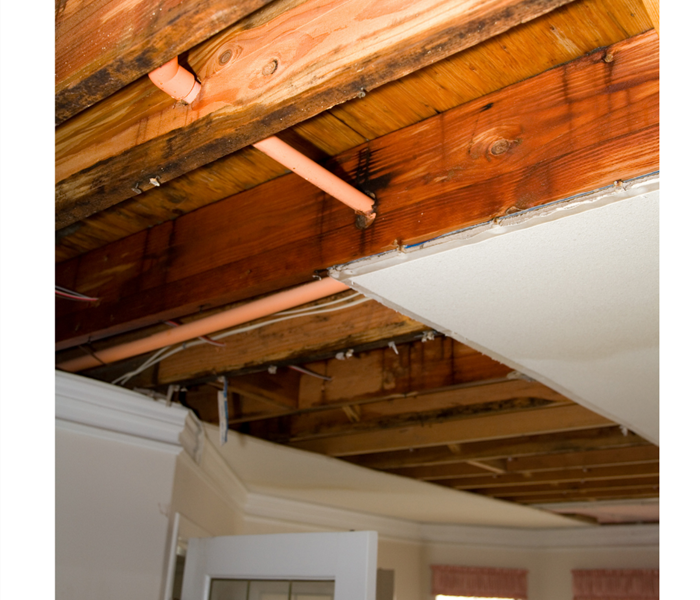 Commercial Water Damage Events Present Unique Challenges.
Commercial Water Damage Events Present Unique Challenges.
Flooding and water damage events at Billings, Montana commercial properties are often complex with numerous issues that require a knowledgeable and flexible response. Whether we’re dealing with a relatively small water cleanup scenario or a large scale event, we work quickly to assess each unique situation and isolate the damaged area. In many instances, normal operations can continue in a temporary space while we restore your facility.
Restoring Commercial Properties Presents Unique Challenges
Our professionals are trained to be mindful of legal and environmental concerns and strive to fully restore the damaged area while working within your budgetary constraints. We understand that every hour spent cleaning up is an hour of lost revenue and productivity. So when an emergency situation arises in your business, give us a call and we’ll be there fast with the help you need.
About SERVPRO of Billings
SERVPRO of Billings specializes in the cleanup and restoration of commercial and residential property after a water damage event. Our staff is highly trained in property damage restoration. From initial and ongoing training at SERVPRO’s corporate training facility to regular IICRC-industry certification, rest assured our staff is equipped with the knowledge to restore your property.
3 Ways Hail Can Damage a Business
2/16/2022 (Permalink)
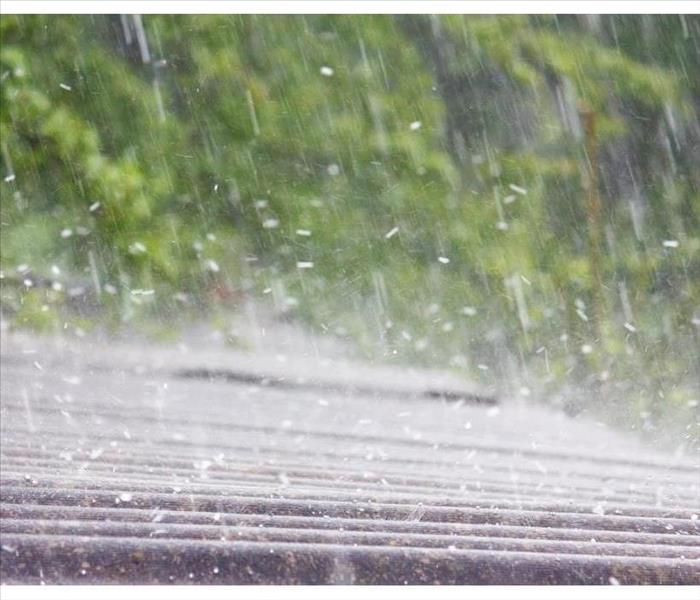 Hailstorm in Laurel, MT.
Hailstorm in Laurel, MT.
Three Ways Hail Can Harm Your Business
If your business in Laurel, MT, is impacted by hail, some issues, such as roof damage, are obvious. However, problems from storms are not always evident. Fortunately, if you are aware of the ways hail can affect your business, you can better prepare before it occurs.
1. Water Damage
When a hailstorm hits, many people do not think that water damage will happen as a result. However, hail can cause issues in a building if there is a problem with the roof or if ice chunks have broken a window and have allowed rain to enter the property. Attics and rooms that are closest to the roof are especially likely to experience water damage, which can in turn cause mold if the source of the moisture is not quickly eliminated.
2. Roof Issues
Unfortunately, hail often results in a building sustaining major roof damage. Even hail that appears small in size can cause shingles to become cracked or come off. If an area on your building’s roof has lost or damaged shingles, this can increase the likelihood of a leak, which may lead to even more problems in the interior of your business.
3. Destruction to Siding
While hail can cause roof and water damage, it can also harm a building’s siding. Material that is older is more likely to crack as a result of hail, and strong winds combined with ice can cause the siding to come off of a building entirely. If your structure’s exterior needs to be replaced and your business is located in an area that is prone to storms, it can be helpful to install siding that is made of more durable material.
Knowing that heavy storms can cause water, siding and roof damage can make it easier to take steps to prevent major hail damage from occurring. If your business has been impacted by severe weather, it could be useful to work with storm restoration experts.
3 Reasons Mold Has an Odor
12/31/2021 (Permalink)
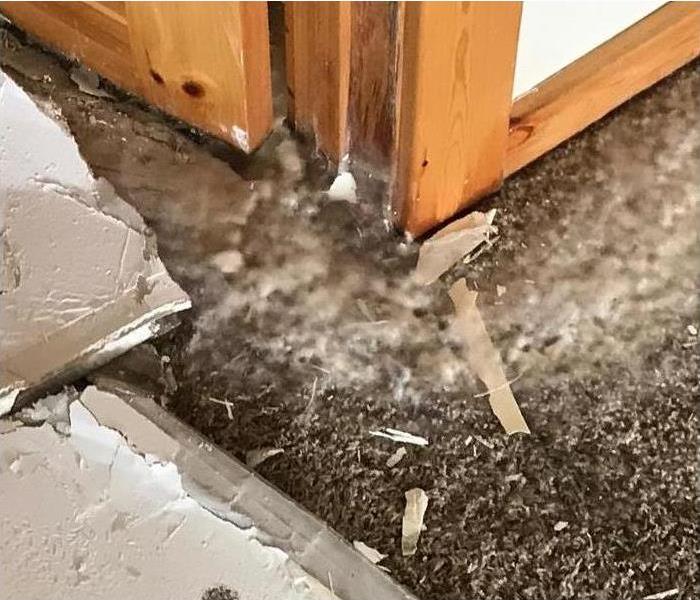 Mold damage in Comanche, MT.
Mold damage in Comanche, MT.
Why Mold Has An Odor?
Mold can take hold in your Comanche, MT, business before you realize it. This fungus can grow for many reasons, but mostly due to the introduction of moisture into an area. A flood, leaking pipes or even a
content in the air can cause mold growth. While not all mold has a powerful odor, some can smell quite strong, and the reasons why may surprise you.
1. Initial Spread
Once mold spores take hold of a surface, they eat away at the material and start to grow. This growth can spread quite rapidly the more it eats, and its byproducts can produce the odor that is so often associated with mold. There are many ways to interpret this odor, but it is most often described as
- Damp
- Dirty (or like dirty laundry)
- Musty
If you catch a whiff of these smells often, you may have a mold problem in your building.
2. Environment
The musty odor of mold can change or grow stronger depending on the environment in which it grows. For example, if the space is humid and often exposed to sunlight, the smell may be more powerful. If other substances are present, the mold may bond or interact with them, causing the smell to change and become even more unpleasant.
3. Rate of Growth
The faster mold grows and spreads, the stronger the scent may be. If mold grows unchecked behind a wall or under a restroom cabinet, you may notice the smell before you find the actual mold. A mold remediation company can help you target and eliminate the problem, then advise you on how to prevent the issue from occurring again.
When mold invades your Comanche, MT, business, it can cause unpleasant odors that air fresheners cannot eliminate. Having a professional eliminate mold growth at the source can help your store, factory or office space smell fresh and clean again.
Why Is Emergency Sprinkler Maintenance Important?
10/29/2021 (Permalink)
 Many commercial buildings are required to have a fire sprinkler system in place.
Many commercial buildings are required to have a fire sprinkler system in place.
What Is the Importance of Emergency Sprinkler Maintenance?
In Comanche, MT, many commercial buildings are required to have a fire sprinkler system in place. This system plays a major role in putting out fires. To get the best benefit, you have to have your sprinklers maintained and inspected regularly. A fire restoration specialist may be able to help you understand the importance of this emergency system. A working system can help do the following:
• Contain a Fire: While other alarm systems warn occupants of the potential danger of a fire, the fire sprinkler actually works to start dampening the flames. While the water isn't always enough to completely put out the fire, it usually helps slow down the growth.
• Increase Personal Safety: Because the sprinklers work to contain and suppress flames, they help keep people safe. The fire suppression system can even give firefighters more time to help get trapped people out of the building.
• Reduce Property Damage: Flames can turn your property into ashes fairly quickly. When you add the deluge of water to that scenario, you end up with less loss. Some of your belongings could now have water damage, but that's better than completely losing your possessions.
• Sense Fires: A well-maintained fire sprinkler system turns on when a fire breaks out. Each sprinkler head has a sensor that reads heat, and they only turn on when the heat is at a specific temperature.
• Protect One Area: Not every sprinkler in the system has to turn on when a fire erupts. If you maintain your sprinklers properly, you may be able to rely on only one area of heads turning on. This can help save you from water damage in the rest of your building.
If you don't do regular fire sprinkler cleanup in your commercial building, you could be leaving yourself in harm's way. The system is very useful in quenching and slowing down flames, but it can only work when it is properly maintained.
Box of Horrors: Cleaning the Office Fridge
7/22/2021 (Permalink)
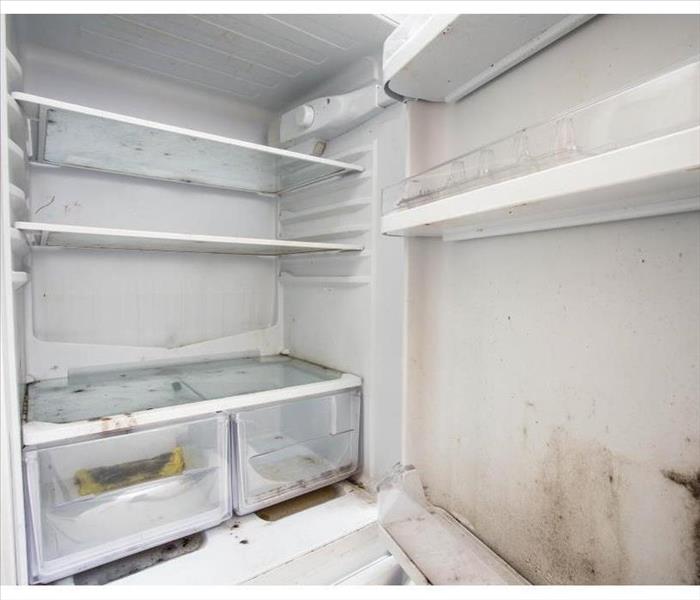 No one wants to see fridge mold.
No one wants to see fridge mold.
Cleaning the Office Fridge: A Box of Horrors
If your pulse quickens and you take a deep breath before opening the office fridge, you are probably not overreacting. Communal refrigerators in the workplace are notorious for developing fridge mold and the nauseous sights and smells that go along with it. All hope is not lost, though. You can play an integral role in preventing fridge funk in your office in Laurel, MT, by taking charge of the cleaning of the office fridge.
Common Causes
Before you can prevent a problem, you have to know what causes it. When it comes to items that contribute to the mold smell that assaults your senses, neglect is the most likely culprit. Food gets forgotten for many reasons:
- Office party leftovers that someone didn't want to go to waste but made no actual plans to use
- Well-intentioned lunch that was abandoned in favor of a spontaneous office outing
- Leftovers that are abandoned and left to fester over the weekend
- Employees forgetting to take their lunch breaks
You can't make people remember to eat the food they put in the office refrigerator, but you can help prevent fridge mold by providing stickers and asking them to date anything they put in the fridge. Let them know that food left longer than three days will be thrown out.
Fridge Cleanup
At least once a week, someone needs to clean the fridge. Not many people will sign up for this job. If you do not want the problem to get so bad that you have to hire remediation experts to take care of it, however, it is a good idea to volunteer or offer an incentive to someone else to take on disinfecting the fridge on a regular basis. The more often you clean, the less disgusting the task will be.
No one wants to see fridge mold in the office refrigerator, but without regular cleaning, it is almost a certainty. With a weekly cleaning schedule and a little cooperation from other employees, you can make your office fridge useful rather than scary.
Cleaning a Commercial Roof: Five Steps
7/15/2021 (Permalink)
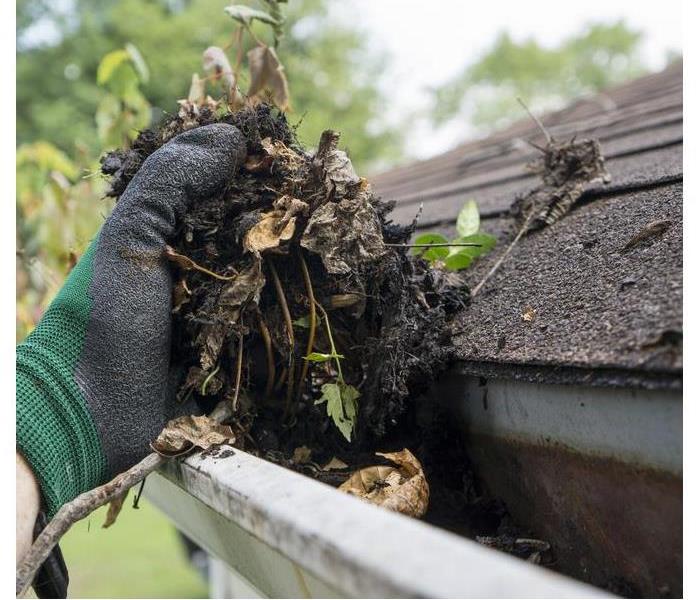 Keep your gutters clean.
Keep your gutters clean.
Cleaning a Commercial Roof
If you want to avoid a roof leak in your Billings, MT, business’s future, it is important to keep your roof clean and clear of unwanted materials. If you are not sure how to get started on your cleaning plan, the following five steps should help.
1. Inspect For Existing Damage
It is important to check your roof and see if there are any pre-existing issues, such as wind damage, from a previous storm. Such damage could include loose or cracked shingles or other physical issues affecting the roof’s materials.
2. Clean Gutters
Things such as little branches and other small objects may be stuck in your gutters. It is a good idea to check for such items in gutters as part of your rooftop cleaning plan so you do not end up with backed-up water down the road.
3. Clear Storm Drains
Storm drains can get clogged up with the same objects that get stuck in gutters. Make sure to check them out and clear any garbage from them. Like with the gutters, a storm drain that is backed up will not be able to efficiently clear water in the event of a storm.
4. Clean Your Roof
One of the worst causes of a roof leak is wetness. Prevent your roof from accumulating dampness by removing leaves or other objects that are holding water on the top of your building.
5. Consider Professional Help
If there any loose or damaged shingles, now is the time to get them fixed, possibly with help from professionals if the loss is severe. Commercial storm restoration services might be a good choice if you should be so unfortunate as to have destructive water damage or debris that requires more skilled assistance. It is better to get help than to embark on a task that you are not confident you can handle yourself.
When it comes down to it, you never want to put the integrity of your commercial building at risk. That is why it is important to have a cleaning plan in place to keep your property in top shape and to help prevent a future roof leak.
The Best Practices for Content Cleaning After a Fire
5/10/2021 (Permalink)
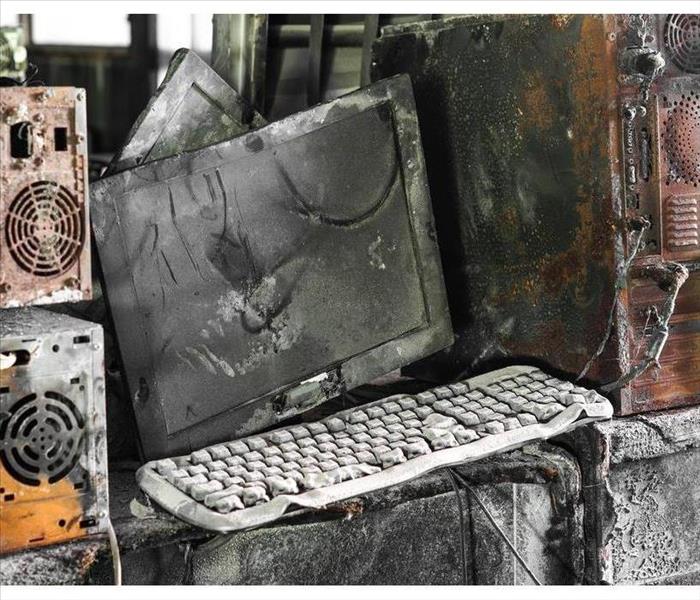 Computer office damaged by fire.
Computer office damaged by fire.
When it comes to the most efficient cleaning of your building's contents after a fire, knowledge and experience are key factors. For example, certified technicians know that dry-cleaning is the best choice for clothes and fabrics damaged by smoke odors and soot. They also know that ultrasonic methods work better for non-porous items. Experienced technicians will choose from a variety of cleaning methods to get the best results for each particular item. They will also pretest items to see if they can be cleaned sufficiently; this saves time and money.
The Option for Content Storage
A professional fire mitigation company sometimes removes items from your building. This has several benefits in terms of the overall restoration job:
- A more efficient restoration process
- Better protection for fragile contents
- More attention to individual items
If dry-cleaning is necessary, a move-out provides better access to the clothes or furniture. The removal of the items from your company in Laurel, MT, is done carefully and efficiently, making sure nothing is broken in the process. The items will be returned to your company based on its needs.
The Possibilities for Content Cleaning
When done effectively, the skilled cleaning of items can save a company extra expenses. Technicians can often restore items at a fraction of the cost of replacing them. For certain items, they will use methods such as foam cleaning and immersion cleaning, while for more fragile items they are more likely to rely on spray and wipe techniques. Abrasive cleaning, which involves agitation of dirty surfaces, is appropriate in some circumstances. Wet cleaning often works best for removing heavy to moderate residues.
Dry-cleaning is best used for cleaning light residues as the result of a fire, or for advanced cleaning before wet cleaning. Trained technicians will look for the best cleaning method for each item, using their knowledge and experience to make the right choices.
5 Pieces of Essential Equipment for Cleaning Mold
2/2/2021 (Permalink)
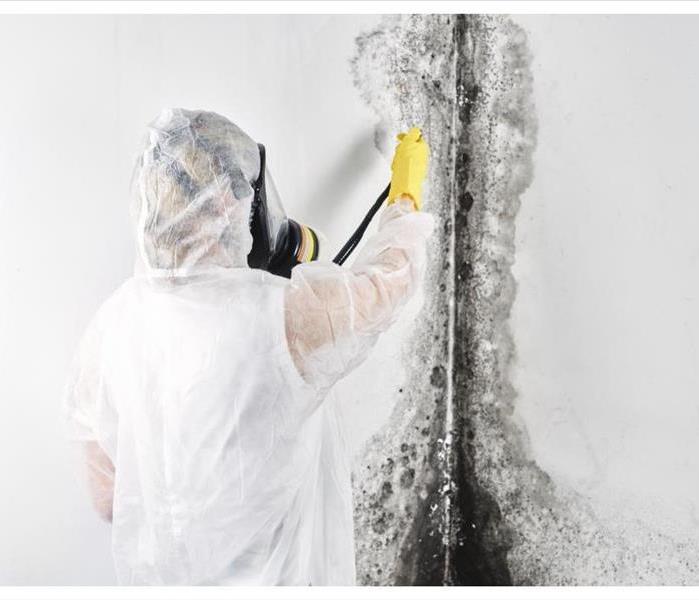 Mold removal is a potentially dangerous activity, call a team of qualified experts to clean the damaged area.
Mold removal is a potentially dangerous activity, call a team of qualified experts to clean the damaged area.
Five Items That Should Always Be Used When Removing Mold
In the unfortunate event that your office in Billings, MT, becomes infested with mold, quick removal is essential. If you elect to tackle the cleaning task without professional help, use proper equipment to protect yourself from mold’s effects. Here are five items that should always be used in conjunction with fungal scrubbing.
1. Respirator
Perhaps the most critical of accessories is the respirator. Because it prevents workers from breathing in mold particles, wearing a mask is absolutely required. There are many types of filtering masks commercially available, from inexpensive disposables to highly expensive beauties. You should have no trouble finding an appropriate selection that matches your budget and taste.
2. Gloves
Like masks, there are a wide variety of gloves available. Whether you choose ones made out of latex, vinyl or nitrile, always protect your hands with the proper fit. No matter what style of glove you settle on, avoid touching your face when dealing with mold.
3. Hazard Suits
Protective clothing suits need to be worn when in proximity to any mold growth. Tyvek makes a one-piece that can be conveniently slipped over regular clothes. Hazard suits can be difficult to find, which is one reason allowing mold removal professionals to handle the task for you is a sensible alternative.
4. Goggles
Naturally, safety goggles prevent mold spores from floating into your eyes, but they also stop chemicals used for cleaning from splashing into them as well. Disturbing spores inevitably causes them to waft into the air, making goggles an absolute necessity.
5. Hair and Shoe Coverings
Your head and feet are susceptible to collecting fungal matter. Avoid spreading spores throughout the office by using disposable protectors. Be certain to don fresh ones before every mold cleanup session.
Mold removal is a potentially dangerous activity. Unless you use a team of qualified experts to clean the compromised area on your behalf, protect yourself and the rest of your team by acquiring the correct gear.
3 Tips for Using a Fire Extinguisher
1/15/2021 (Permalink)
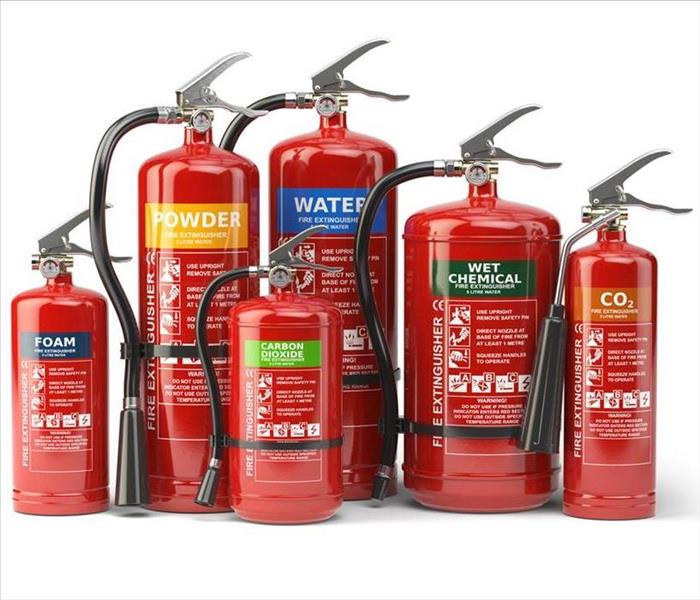 There are five classes of fire extinguishers, use the right one
There are five classes of fire extinguishers, use the right one
3 Tips for Using a Fire Extinguisher
Fire extinguishers are essential fire suppression equipment. Commercial building owners and occupants should know how to choose and safely use any fire extinguisher. Applying the right type of suppressant to open flames has the potential to minimize fire damage and safety risks during a fire at a commercial building in Billings, MT.
1. Use the Right Extinguisher Class
There are five classes of fire extinguishers and commercial buildings may be equipped with one or more extinguisher types. Class A extinguishers contain suppressants for ordinary combustibles, while Class B extinguishers put out blazes fed by flammable liquids. Class K extinguishers are formulated for commercial kitchen fires. Class C extinguishers contain suppressants for electrical fires, and Class D extinguishers put out fires fueled by combustible metals.
2. Do the PASS Method
The PASS method is the best way to limit fire damage. Pull the pin, aim the fire extinguisher hose at the base of a blaze, squeeze the handle and sweep spray from side to side. Although this method puts out some fires, the force of the spray may spread grease fires. In these cases, dousing flames or limiting airflow may prove effective.
3. Plan Ahead for Evacuation
Before using an extinguisher, a building occupant should make sure that he or she will be able to safely evacuate the area if it is not possible to put out the flames. Anyone attempting to suppress a fire should exercise caution to prevent flames from blocking off the most convenient route out of a burning building.
These fire extinguisher tips are only helpful if a commercial building is equipped with the proper class and number of fire extinguishers. The fire hazard level of a structure will determine the number and positioning of extinguishers. Fire safety codes may require that extinguishers be spaced 30, 50 or 75 feet apart at a building in Billings, MT.
What Is the Proper Procedure for Sewage Cleanup?
1/6/2021 (Permalink)
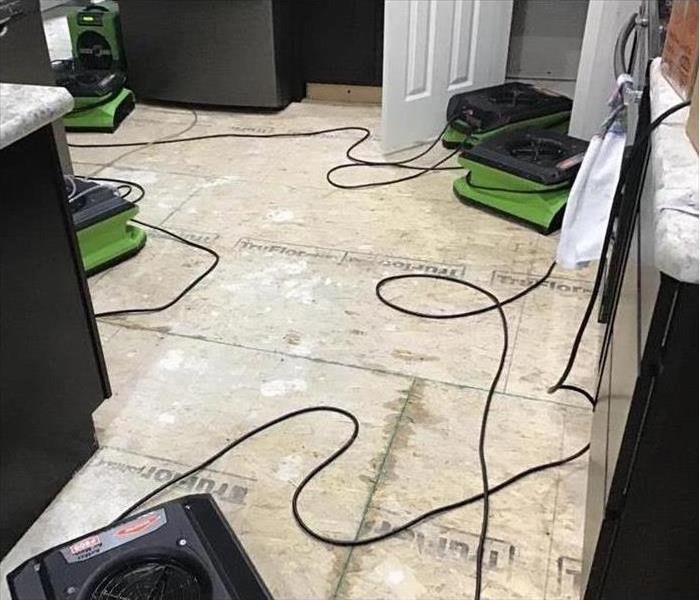 Everything must be dried completely as quickly as possible
Everything must be dried completely as quickly as possible
Remediation Process After Sewage Damage
A flooded toilet is bad enough, but one caused by a sewer backup can bring on a whole new level of panic. Not only do you have to deal with standing water but heavily contaminated water. Every minute counts when it comes to sewage cleanup. The remediation process must begin immediately.
1. Extract Standing Water
First, all of the standing water must be removed. A wet/dry vacuum typically is the most efficient tool for extracting water if you’re doing it yourself. A Laurel, MT, water damage restoration company will use professional-strength vacuums for this.
2. Remove Everything From the Affected Area
Once the standing water has been extracted, everything needs to be removed from the affected area. Saturated carpeting and carpet padding will not be salvageable. It will have to be pulled up and thrown away. If your building has drywall, part of it will probably have to be taken down since it’s very porous and soaks up water.
3. Separate Salvageable Items
A significant part of the sewage cleanup process is determining what is salvageable and what isn’t. Mold can begin growing on damp materials in as little as 24 hours. If those elements can’t be fully dried within 48 hours, they will most likely need to be disposed of.
4. Clean and Disinfect
In the event of a sewer backup, everything in the affected area must be cleaned and disinfected thoroughly. This includes anything that the contaminated water has touched, including walls, floors and furniture. Porous materials probably won’t be able to be cleaned well enough to be saved.
5. Dry the Area
Everything must be dried completely as quickly as possible. Open windows and doors to let the fresh air blow through the area. Also, run fans dehumidifiers and portable heaters to assist in drying the area faster.
If your commercial building sustains damage from a sewer backup, begin the sewage cleanup process right away. The sooner remediation begins, the sooner business resumes as usual.
6 Reasons You Need Business Insurance
10/30/2020 (Permalink)
 Business insurance reduces the risk of potential, uncertain losses
Business insurance reduces the risk of potential, uncertain losses
Here's A Closer Look At Its Benefits
Like most insurance, business insurance is a hedge against future uncertainties. It protects business owners in Comanche, MT, from unexpected costs they would otherwise have to pay out-of-pocket, such as professional remediation services stemming from water damage and water cleanup after a superstorm, for example.
By law, businesses must carry certain types of insurance (workers compensation and unemployment and disability insurance). However, savvy business owners take out an inclusive business owner's policy, which provides all-in-one coverage that merges property, liability and business income (or interruption) insurance. Under this umbrella, you're insulated against the costs of property damage, liability claims and lost income if your business is temporarily shuttered because of that super storm.
Ensures your business stays operational. In the example of extreme weather, a BOP covers water damage to your property from broken pipes, leaks or flooding. It underwrites revenue losses during business closure for cleanup and repairs by paying your rent or mortgage, loan payments, utilities, taxes and payroll for a defined time period. It also can be structured to offer salary protection for your employees.
Litigation. Features financial protection from lawsuits, liability claims and the expense of legal defense.
Personnel protection. Financially safeguards your employees from injuries on the job and protects you from claims and lawsuits.
Credibility. Demonstrates your business' operational strength by assuring clients, customers, suppliers and employees that it can financially withstand emergencies, legal issues or other unforeseen circumstances that threaten financial stability.
Contracts require a BOP. Leasing or rental agreements, loan agreements and client contracts all may stipulate a requirement for insurance.
Peace of mind. Provides a measure of security by protecting your interests from factors outside your control.
Business insurance reduces the risk of potential, uncertain losses. It neutralizes the financial pressures that can build up from an unexpected emergency — like water damage to your building — or simply protect your people and property as you manage the day-to-day business of business. It's worth considering.
How Do Sprinklers Function During a Fire?
9/24/2020 (Permalink)
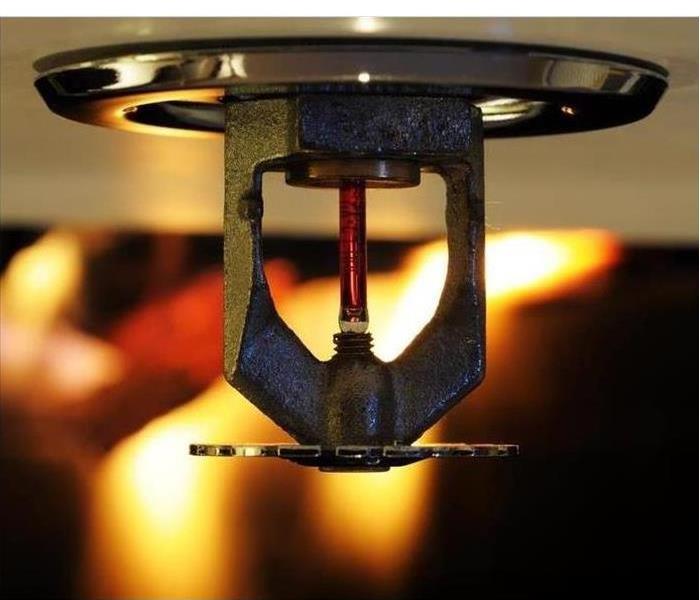 A fire sprinkler can help to limit the amount of damage a commercial property sustains from either a fire or a fire suppression system
A fire sprinkler can help to limit the amount of damage a commercial property sustains from either a fire or a fire suppression system
How Do Sprinklers Function During a Fire?
Fire sprinklers significantly reduce the extent of property loss and the risks to occupants of a commercial building. Read on to find out how a fire sprinkler can suppress or extinguish flames in a commercial property.
1. A sprinkler head turns on when it detects high temperatures. Fire sprinklers turn on when high heat triggers the system rather than being activated by smoke. Hot air rises during a fire and spreads across the ceiling until it reaches a sprinkler head and activates the fire suppression system. Many sprinkler head designs feature a glass bulb filled with a glycerin-based liquid that expands when it comes into contact with air between 135 and 165 degrees Fahrenheit. The liquid shatters the glass container when the surrounding air reaches temperatures in this range, activating the sprinkler head.
2. Sprinkler heads dispense pressurized water from the pipe system. Each fire sprinkler head is attached to a pipe that brings in water. When a sprinkler head becomes activated, a valve connected to the head opens and sends water out through the sprinkler head to douse the fire. Water pressure is important, as it causes water to spray out over a larger area.
3. Sprinkler heads function individually to limit water damage. Each sprinkler head in a sprinkler system functions separately. Many small fires can be extinguished with only one or two activated sprinkler heads. Sprinklers pose less of a water damage risk to a property than a fire hose. Some restoration specialists estimate that the average sprinkler system dispenses six times less water than a hose.
A fire sprinkler can help to limit the amount of damage a commercial property sustains from either a fire or a fire suppression system. If you need to clean and restore damage caused by a fire or schedule fire sprinkler cleanup, contact a certified commercial restoration company in Billings, MT.
Protect Your Building After a Fire
8/25/2020 (Permalink)
A fire can be one of the worst things a company can go through. In addition to the fire damage, you will have to deal with a business interruption that leaves workers idle and puts a stop to your business operations. Once a fire happens and has been put out the emphasis from that point is on reducing damage and getting the business up and running again. Instead of floundering around and reinventing the wheel, it's best to work with the fire restoration experts in Acton, MT. They have a proven process in place that addresses water and soot damage, security, safety and other issues. By bringing in a team of experienced workers before the last embers have been extinguished, they can begin the process of reopening your business.
Secure the Building
One of the first steps is to protect your building from looting. Word will get out that a fire has happened and this often attracts vandals and thieves. It's imperative that the building is secured quickly with these measures;
- Solid locks on the doors
- Boards over broken windows
- A tarp over a damaged roof
- Surveillance of the grounds and property
The goal here is to prevent unauthorized access. This warns off looters, but it also protects your company from people coming on the grounds and getting injured. An injury on your property after a fire could result in a lawsuit.
Clean Up the Fire
Once the building is secured the fire cleanup can begin in earnest. This will involve ridding the building of water used in fighting the fire. The drying process uses dehumidifiers and air movers to withdraw excess moisture. More specialized equipment is used to remove smoke odors and soot from the walls, upholstery and fabrics. Industrial air scrubbers and fogging equipment are employed to clean and sanitize the building. Once the fire damage is cleaned up, your company can begin normal operations again.
What Happens When Fire and Water Damage Combine?
4/20/2020 (Permalink)
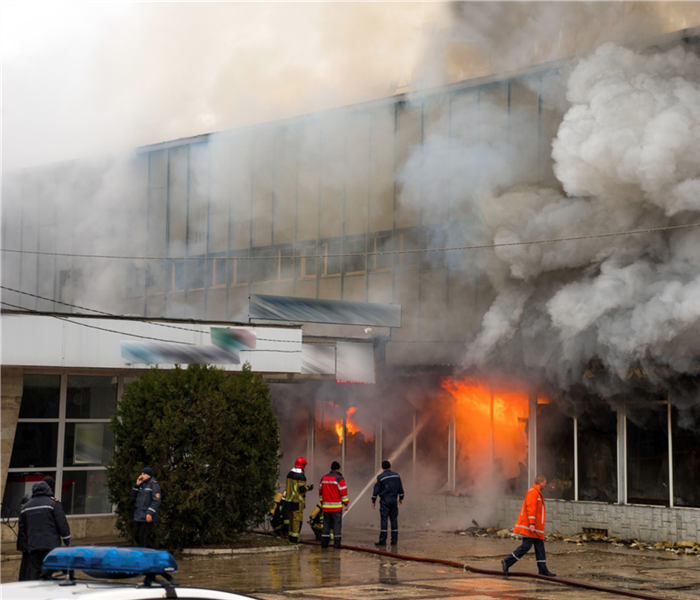 Fire damage in a Comanche, MT commercial building
Fire damage in a Comanche, MT commercial building
How Water Compounds Fire Damage
The consequences of a fire at a commercial building in Comanche, MT, can include thousands of dollars in damage to building materials and contents. A burnt or singed structure and contents are only part of the aftermath of many fires. If sprinklers or hoses were used to extinguish the blaze, water cleanup may also be necessary. Find out more about how water compounds fire damage.
Standing Water
As a fire burns through building materials and contents, sprinklers and fire hoses can release hundreds of gallons of water into a structure. Water intensifies damage caused by a fire in several ways:
- Excessive weight
- Heightened risk of structural failure
- Increased risk of mold
Sprinklers and hoses release clean water. As soon as this water mixes with soot and smoke, it becomes highly contaminated Category Three water damage. Before fire and smoke cleanup can take place, all standing water must be pumped out of a structure.
Staining
The severity of staining increases rapidly as long as residual moisture remains in a structure. Soot and smoke damage become more set in whenever water is present. If water cleanup takes place as soon as possible, restoration measures may still be sufficient to fix partial damage. Burnt or singed materials must be replaced.
Structural Damage
Just one inch of standing water throughout an area can add thousands of pounds of weight to a structure. A building with severe fire damage may be likely to succumb to structural damage if standing water is present. Lingering moisture can also undermine weakened building materials. Timely cleanup and mitigation measures may limit the extent of damage.
Many fire cleanup jobs involve some water damage. Restoration professionals have experience with the unique requirements of water cleanup after a fire. If water is standing at a fire-damaged structure in Comanche, MT, the owners of a building or business should document this damage for a commercial insurance claim and pursue mitigation.
Prevent Burst Pipes at Your Commercial Building
3/4/2020 (Permalink)
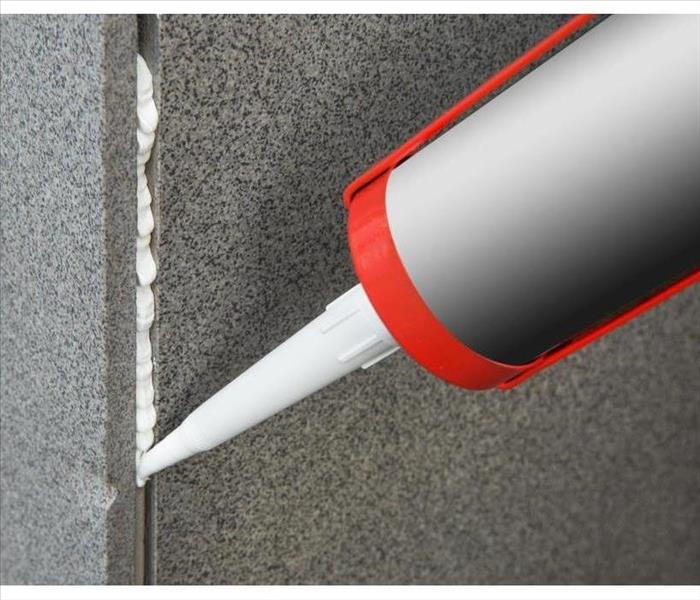 Seal cracks around your building
Seal cracks around your building
Tips To Prepare Your Building From Freezing Temperatures
Preparing your commercial building for winter weather in Billings, MT is a must. It can mean the difference between keeping your business running smoothly and having to close up shop for a while. A burst pipe from improper insulation can wreak havoc on a building. Follow these tips to prepare your building for the impending freezing temperatures:
1. Keep Thermostat Properly Adjusted
Keep the thermostat set to at least 50 degrees even if the building isn’t in use. Lower indoor temperatures can contribute to freezing pipes if temperatures are below freezing outside.
2. Seal Cracks
Check your building for any air leaks that could be letting cold air get in. Sealing cracks around windows, pipes, electrical wiring, and vents can help to keep your building warmer while saving on your heating bill.
3. Insulate Exposed Pipes
Without proper insulation, water in your pipes will freeze and expand in extreme winter temperatures. This can cause a burst pipe. There are several types of foam insulation from which to choose, including DIY covers to spray foam for tighter areas. Insulating pipes can also prevent condensation from forming on pipes, potentially preventing the occurrence of standing water (a cause of mold and structural problems). Wrap particularly vulnerable pipes in heat tape for added protection.
4. Keep Interior Doors Open
Keep the air flowing through the building by keeping all interior doors open. This is particularly important for rooms that have no vents and rooms with plumbing. Keeping cabinet doors open in bathrooms and kitchens during extreme cold will allow the building’s ambient temperature to help prevent pipes from freezing.
5. Let Faucets Drip
During extreme winter weather, pressure can build up in water pipes, potentially causing a frozen pipe to burst. Put your faucets (particularly rooms with plumbing on outside walls) on a slow drip to keep the pressure low.
It’s important to take the necessary steps to protect your business before winter temperatures strike. If your building incurs damage from a burst pipe, water damage cleanup professionals can help.
Can Mold Be Present Even When Not Visible?
1/9/2020 (Permalink)
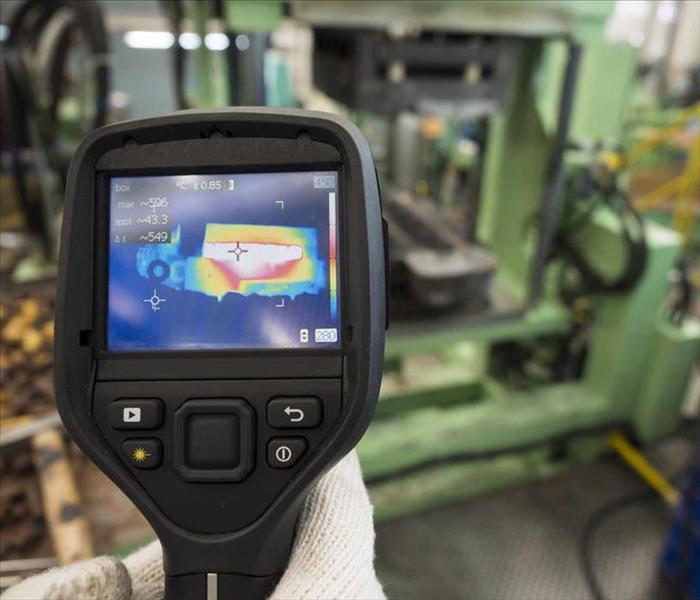 When trying to locate a mold smell, an infrared camera can be a handy device
When trying to locate a mold smell, an infrared camera can be a handy device
Can Mold Be Present Even When Not Visible?
Most people stumble across mold in the workplace by finding the tell-tale discoloring on the ceiling or the walls. Sometimes, though, the mold may not be visible and could be hiding behind a curtain or a wall. Just because the mold isn't visible doesn't mean it isn't creating an unhealthy environment for workers, as well as causing damage to property. If you are aware of a mold smell, usually described as a musty odor, it's probably time to call in a mold remediation company in Billings, MT. Trained technicians have a number of technologies that can discover mold in the darkest corners of your commercial property.
High-Tech Solutions
When trying to locate a mold smell, an infrared camera can be a handy device. The best cameras for this job use infrared thermography, and it works using the following principles:
- It produces images of heat radiation
- It allows finding the location of that fungus smell
- It can detect mold even before it is visible
- It should be used in coordination with the experience of the technician and other technology
Another possibility is to send in canines that have been trained in scent detection. The dogs, picking up on the slightest mildew smell, are able to find mold under carpeting and behind walls. Air samples and lab tests are another way to find mold in its early stages or before it is visible.
Accurate Answers
If you suspect mold at your company, you want fast and correct answers. If you wait too long, the mold spores can spread throughout the building, making the job of cleanup tougher and more expensive. A mold smell is a good indication that you have a problem somewhere. An indoor environmental specialist has the tools to find the mold and to do an assessment of how serious the problem is. A rapid response will restore your company to the way it was before mold gained a foothold.
3 Contamination Levels for Commercial Water Damage
12/31/2019 (Permalink)
 Category 1 water damage comes from a clean water source. An example would be a fresh water line for a refrigerator
Category 1 water damage comes from a clean water source. An example would be a fresh water line for a refrigerator
3 Contamination Levels for Commercial Water Damage
Water can cause serious damage to commercial property. If your Acton, MT, business has sustained water damage, due to flooding or a broken pipe, you may benefit from understanding the three levels of contamination. Then you will be prepared to implement the best remediation plan.
Category 1
This low level of contamination, termed “clean water” damage, reflects supply-side sources of water, or stormwater that has not yet touched the ground. The following would likely result in Category 1 damage.
- Overflowing bathtub or shower
- Leaking water heater
- Snowmelt leaking through a roof
- Broken supply line from a refrigerator ice maker
- Leaking supply-side water pipe of any kind
Your business insurance should cover Category 1 damage, as long as flooding was not present. Your contamination level is categorized by the most toxic water source present.
Category 2
“Gray water,” is generally used water leaking from a washing machine, sink or shower drain. It may contain grease, dirt, detergents or food particles. Disinfectants are generally used to sanitize items with Category 2 damage. Your commercial insurance will likely cover this type of cleanup.
Category 3
This highest level of water contamination is termed “black water.” It can be hazardous to humans as it can contain toxic chemicals, bacteria and sewage. Category 3 damage arises when water from flooding or a sewer line back-up enters your structure. If you have this type of damage, it’s important to consult with a professional remediation service for assistance with the cleanup and remediation plan.
Your conventional insurance policy may cover Category 3 water damage, but it will likely have an exception for floodwater. Flood-related damage requires a separate insurance policy, so it’s important to consult your agent, so you can decide how to proceed.
When your business is affected by flood damage from an extreme storm or broken pipe, it can be stressful and expensive to remedy the damage. It’s important to determine the contamination level right away and decide on a strategy for cleanup and restoration. Once the cleanup is underway, you may be surprised at how soon your company and your stress level will be restored to normal.
3 Common Irrigation System Problems and How To Solve Them
9/26/2019 (Permalink)
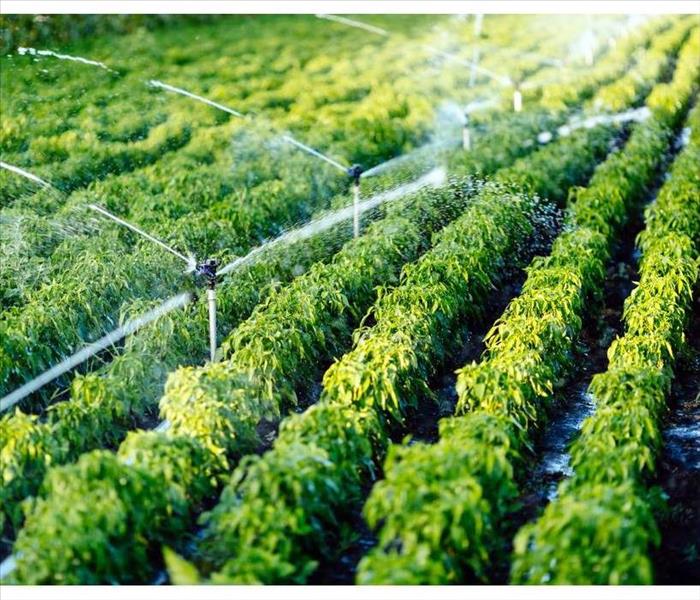 Knowledge is power when it comes to maintaining your irrigation system
Knowledge is power when it comes to maintaining your irrigation system
3 Common Irrigation System Problems
Knowledge is power when it comes to maintaining your irrigation system in Comanche, MT. Here are three of the most common irrigation problems and how to troubleshoot them.
1. The Display Is Blank
If your controller's display is blank, the first thing you should do is make sure that it's plugged in and powered up. If the system has been unplugged or recently subjected to a power outage, the controller may just need to be restarted. When the display begins working again, check that each zone can be activated. If not, that may suggest valve damage.
2. Coverage Is Uneven
When all but one area of your land is green and healthy, that brown or otherwise discolored spot may suggest that your sprinkler overage is uneven. To fix it, first check the controller to see that the zone is activated. Next, check the sprinkler heads and make sure they're not broken or blocked by debris and that they haven't been knocked off-course, thereby leaving that discolored area un-watered. Sprinklers can easily sink or tilt without regular attention.
3. Water Pressure Seems Low
There are several reasons why your irrigation system might see a decrease in pressure:
- Clogs due to dirt, sticks, and rocks
- Open valves
- Cracked pipes
- Electrical problems
One issue is frequently overlooked, however, and that's the addition of extra sprinkler heads. If you've added to your system over the years, those additional sprinklers will zap the system's overall pressure distribution and likely affect system function. To fix this, you'll need to boost the system's pressure output to accommodate the increase in sprinklers.
Overall, the best defense against most types of pressure problem is usually vigilance. Some irrigation systems include a water pressure gauge so you can monitor things. If yours doesn't, it would likely be a wise investment.
Familiarizing yourself with your irrigation system, how it works, and why it may stop working is the first step in upkeep. By knowing what to look for, you can prevent small performance issues from turning into a need for serious water damage services.
Toilet Overflows: Putting Your Company Back Together
6/21/2019 (Permalink)
 Many toilet overflows are preventable
Many toilet overflows are preventable
Take the Following Steps When Facing a Flooded Toilet
No business owner in Acton, MT wants to deal with a flooding problem, but one due to a toilet overflowing is particularly unpleasant. Companies often deal with this problem on an elevated floor, making the sewer damage extend to floors and ceilings on multiple levels. Here are some steps to take when facing a flooded toilet.
1. Shut Off the Water and Contact the Professionals
The first step after noticing a problem is to stop the source by turning off the water. Since it’s a toilet that is overflowing, you can assume it is contaminated water. Unless it’s a very small overflow, the dirty water probably leaked into the floor and even the ceiling of the floor below. In this instance, you absolutely need to contact a disaster recovery company. A sewage company can specialize in cleaning up what is known as black water to avoid any health risks. It unfortunately may involve removing flooring or ceilings, but it is essential for the safety of your employees.
2. Call Your Insurance Company
The next step is to contact your insurance company. The cause of the flooded toilet often determines your level of coverage. Sewer damage is different than flooding caused by toilet clogs, so your insurance specialist would be the best person to interpret your policy as it relates to the cause of your problem.
3. Prevent Future Problems
Many toilet overflows are preventable. They are caused by people flushing items other than standard toilet paper. In these instances, training employees and posting signs in restrooms can prevent future problems. Chances are, once a large flood occurs, people will be extremely careful of causing another one. If you have a septic system, it could be a matter of better septic maintenance.
Although it isn’t a foreseeable problem, you can get through problems due to toilets overflowing. Whether it’s caused by sewer damage or human error, make sure to shut off the water and contact your professional restoration and insurance company. Your business will be restored and better poised to handle future issues.
Keep Your Fire Sprinkler System in Check
5/24/2019 (Permalink)
 Fire Damage can be devastating if the Fire Sprinkler System is not in check.
Fire Damage can be devastating if the Fire Sprinkler System is not in check.
Commercial fires can happen anywhere, even in Billings, MT. While it’s impossible to know when they may occur, keeping your building prepared for any disasters is key to preventing a possible tragedy in the future. Most commercial properties operate with a fire suppression system in place, like a working fire sprinkler system. However, since many go unused for long lengths of time, they sometimes fall by the wayside in terms of maintenance. Here are three ways to keep your sprinklers in check so you’ll only have to deal with fire sprinkler cleanup after a situation arises, as opposed to any more horrifying consequences.
3 Ways to Keep Your Fire Sprinkler System in Check
- Check your building’s water pressure. If the building’s other water fixtures generally work fine, then you probably won’t have any issues securing ample water pressure through your sprinkler system. However, due to possible valve closures through the interior of the walls, especially for plumbing through systems that rarely get used, it’s best to do a check to indicate the pressure levels. Calling on fire service professionals can be helpful in completing this process correctly.
- Clean the coatings on your sprinkler heads. Sprinkler heads can collect dirt and debris easily, especially in high traffic areas like kitchens that build up grease deposits. Any coating on the fire sprinkler heads can block full access to water if a fire is in progress, so cleaning the heads is crucial for efficient usage. Clean them with basic degreasing solutions or soap that doesn’t leave residue behind.
- Inspect your non-electric control valves. Building owners should make a habit of checking the control valves if they’re non-electric, as no water can be released without them being open. Electronic valves can be monitored through annual inspections.
Disaster can strike at any moment, so knowing that your fire suppression system is up to code can be reassuring for you and everyone in the building. If your fire sprinkler system in Billings, MT, is maintained properly, handling a little fire sprinkler cleanup after an event occurs might be the only thing you need to worry about.
Recognizing Water Damage in Your Business
5/5/2019 (Permalink)
Running a business in Billings, MT, often comes with the risk of some type of water damage, with causes ranging from heavy storms to internal plumbing issues. Each instance of water damage comes with its own unique challenges, but both water pipe repair companies and insurance companies generally use three different categories to move forward with cleanup, but Category 2 is one of the most common.
Understanding Category 2 Water Damage
All three levels of water damage will likely require water pipe repair. A common misconception is that the cause of the water damage directly correlates to the category; however, the categories are simply based on the contents of the water:
- Category 1: caused by clean water
- Category 2: caused by water that contains a small amount of contamination
- Category 3: caused by water that contains microorganisms, sewage, and other bacteria
Water that causes Category 2 water damage often began as clean water but became slightly contaminated after sitting for too long or soaking through building materials. Category 2 water damage will often contain soap, detergent, and some dirt. The water that causes this damage is typically not considered dangerous to your health, but it should still be dealt with quickly in any business setting.
Causes of Category 2 Water Damage
Category 2 water damage is most easily recognized by the source of the water and how long it has been stagnant.
A few of the most common sources of Category 2 water damage include the following:
- Washing machines
- Dishwashers
- Water that has seeped through from a higher level of a building to a lower level
If any cleaning appliances in your business experience a burst pipe, you may need to seek out water pipe repair to keep the problem from getting worse and call a restoration company in Billings, MT, to completely repair and sanitize the flooded areas.
Upholding High Mold Remediation Standards
4/10/2019 (Permalink)
 Our IICRC- trained technicians use the newest technology to help you keep your property fungus free.
Our IICRC- trained technicians use the newest technology to help you keep your property fungus free.
Mold can attack your company any time water is present, even a tiny bit of water from a pipe that collects condensation for a few hours a day. When mold does appear in your Billings, MT, facility, you’ll want to deal with the issue as quickly as possible, but you also want the problem dealt with using EPA and OSHA standards for commercial buildings. The Institute of Inspection Cleaning and Restoration Certification has established mold standards for all types of remediation, including government required cleaning criteria.
Certification
The IICRC is a third-party organization that sets the standards of cleaning, remediation, and restoration after disasters. The institute’s instructors and class materials are all kept up-to-date using government criteria to teach students the skills required to hold to the highest standards of disaster scene cleanup. Classes often include:
• Water restoration
• Carpet cleaning
• Structural drying
• Fire scene rebuilding
• Document restoration
Upon completion of the required classes, the student receives a mitigation certificate acknowledging he or she has acquired the government-mandated skills and knowledge essential for completing the job. He or she not only knows how to mold clean an area, but he or she can also prevent future mold growth by finding the source of the water and repairing it to the highest of mold standards.
Accreditation
Qualified individuals not only become certified mitigation specialists by attending classes in a specialized school, but they also learn how to maintain the highest industry standards by attending continuing education classes on topics such as black mold, flooding, and scene safety. There are also classes in ethics, working with insurance companies, and advanced mitigation processes.
If you ever find yourself fighting a fungus problem, choose an IICRC-certified team to clean the area. The specially trained individuals can help remove the problem, prevent future growth, and bring your building back to the highest government-mandated and preventative mold standards. You can trust the IICRC-trained technicians to use the newest technology to help you keep your property fungus free.
Smoke Odor Cleanup Methods
1/23/2019 (Permalink)
 Many Billings,MT cleanup technicians will use ozone machines for standard smoke cleanup
Many Billings,MT cleanup technicians will use ozone machines for standard smoke cleanup
Smoke Odor Cleanup Methods
What is that smell? If your commercial property recently suffered from a damaging fire, it’s probably smoke odor. You may already know how to handle structural fire damage, but what can you do about smoke cleaning? Fortunately for you and your business, there are several ways that trained professionals can help. Read on to learn about three methods that your local fire damage restoration company can use to help clean up those unpleasant smells.
1. Ozone Machines
Many Billings, MT, cleanup technicians will use ozone machines for standard smoke cleanup. These handy devices actually destroy the odors in your building, rather than simply covering them up temporarily.
2. Thermal Foggers
A thermal fogger will assist cleanup professionals in alleviating smoke damage by removing odors from carpets, walls and most other common surfaces in your commercial space. A fogger is considered to be the preferred device for smoke cleaning in many cases.
3. Air Filtration Devices
A good air filtration device will remove smoke particles from the air in your building and eliminate most odors. This makes filtration a very good choice for handling smoke cleanup in a large number of fire situations.
Which Method Does My Business Need?
The specific method that your local Billings, MT, cleanup technicians use will likely vary depending on the severity of the situation, what type of building your business is located in and other important factors unique to your location. All of the methods above are excellent in the right situation, but you will need to talk to your on-site smoke cleaning crew about what their cleaning plan is.
Dealing with the aftermath of a commercial fire can be stressful enough without having to worry about lingering effects such as the smell of smoke. However, with all of the cleanup options that professionals have to consider, you really do not have to worry about the odors sticking around for long.
4 Methods for Mitigating Water Damage
9/14/2018 (Permalink)
 Water damaged property?? Call the professionals in to help clean up and prevent secondary damage.
Water damaged property?? Call the professionals in to help clean up and prevent secondary damage.
Water damage can cause serious problems in a commercial property. Whether you are dealing with a supply line leaking or a pipe burst cleanup, here are four methods that may mitigate water damage.
Collect As Much Water As Possible
Try to collect as much water as you can in buckets or other containers. This can help to reduce the extent of water cleanup. Water from a burst pipe or supply line will likely be relatively clean. If the leak comes from any other source, the water may be contaminated. Take precautionary measures depending on the origin of the water.
Remove Spilled Water With Any Available Method
If you have buckets, a mop, towels, or a wet vacuum on hand, try to remove as much water as you can. The problem will persist until you resolve the underlying issue, so it can be smart to contact a plumber as soon as you can.
Rely On a Restoration Service for Major Leaks
If you are dealing with a major leak, you may want to rely on the expertise and specialized equipment of a commercial water damage restoration service for pipe burst cleanup. These professionals can lessen the severity of the problem and help to prevent secondary damage.
Completely Dry the Affected Area
Restoration professionals rely on equipment such as dehumidifiers to thoroughly dry the area of your building affected by a leak. If you are mitigating water damage on your own, you may also want to use a dehumidifier or fans to circulate air, promote faster drying, and try to prevent mold from developing.
These four methods can help you mitigate water damage in a commercial property in Billings, Montana. Whether you need to perform pipe burst cleanup, deal with a supply line leaking, or engage in other water cleanup, the situation can be less severe if you follow these guidelines.
Mold Forms Quickly After a Water Loss
7/16/2018 (Permalink)
 Mold does not have to become inevitable once a house or building has sustained water damage.
Mold does not have to become inevitable once a house or building has sustained water damage.
Water damage is a universally challenging situation in Billings, MT, and everywhere else in the country, and the collateral mold problems associated with it can add insult to injury. If it is significant, there are professionals who can step in to take care of this all-too-common phenomenon.
Mold is an Opportunistic Organism
After the incursion of water through a flood, leak or spill in the right kind of environment, mold can begin to grow in as little as 24 to 48 hours. Learning a few facts about this organism can help anyone master mold prevention.
• There are over 1000 kinds of mold in the U.S., and it grows indoors and outdoors.
• Mold needs moisture, a surface on which to grow, darkness, and nutrients.
• Nutrients for mold include dust, dirt, paper, fabric and many kinds of building material.
• Mold often, but not always, smells musty.
Remediation is an Urgent Matter
Putting off the remediation of mold growth is a serious mistake. What starts out as an inconvenience can literally blossom overnight into a full scale project that displaces residents and incurs significant expense. After the source of the water has been eliminated, it is important to dry all areas thoroughly. Exposing the area to light and air circulation after all excess moisture has been mopped or blotted is important since mold needs darkness to grow. Opening windows and running fans and dehumidifiers are effective in reducing moisture and humidity. Removing any surfaces or materials that mold can feed on deprives the organism of Mold cleanup need not involve lawyers or lawsuits, and tenants always have the option of moving out if the situation becomes untenable.
it's necessary nutrients.
Mold does not have to become inevitable once a house or building has sustained water damage. Taking quick action can nip a mold problem in the bud. For more information, visit http://www.SERVPRObillings.com/.
Business Interruption Insurance Can Save Your Business
6/18/2018 (Permalink)
 Disasters such as fire or flooding can have a devastating effect on a business.
Disasters such as fire or flooding can have a devastating effect on a business.
Many business owners are unaware that a standard insurance property policy limits disaster coverage. It will often cover some business losses and physical damage after a disaster such as fire or flooding, but the standard business policy does not typically cover business disruption losses in Billings, MT.
Coverage
When a damaging event occurs that closes your business, revenue can plummet. Although bills may still arrive and need to be paid, lack of income can often make it difficult to pay your creditors. Fortunately, business interruption insurance can often cover the following:
• Fixed revenue costs during a disaster
• Lost revenue during the business closure
• Temporary operating expenses
That means when your business is hit with an insured event such as large water damage from a broken pipe, and the company needs to close for a month, the business interruption insurance may begin coverage. The insurance may include new store front rent, utilities, and even advertising concerning the temporary location.
Calculation
Although interruption insurance payments can be difficult to figure out, it often involves your exacting business records and past tax returns. The insurance company may investigate profit and loss from previous years, business income and expenses up to the date of the disaster, and projected sales and expenses for the rest of the year. Using available information, the adjuster can often swiftly calculate the lost revenue and business expenditures.
Closure
When a disaster such as flooding occurs, immediately calling in a water repair team can mitigate some of the damages your business may incur. However, it may take much longer than expected to complete building restoration. For this reason, extra expense insurance may be a good way to protect the business during any unexpected closure. The policy can reimburse the company for an amount more than actual operating costs.
Protection
Disasters such as fire or flooding can have a devastating effect on business revenue when the company must close its doors for more than a few days. Business interruption insurance can help you keep company doors open, even if it is from a different location. For more information, visit http://www.SERVPRObillings.com/.
How To Handle Post-Flood Cleanup
3/22/2018 (Permalink)
Don’t let the idea of content cleaning after a flood get you down. It’s never impossible to restore your business to its former glory with proper cleaning and sanitization as long as you know the ins and outs of how to properly recover from flood damage in Billings, MT.
1. Create a Cleanup Plan
The very first step in reclaiming your property after flood damage is to establish a structured, methodical cleanup plan. Identify which cleanup tasks are dependent on others and prioritize key areas first. Section off your floor plan into places that are most to least critical regarding what needs to be handled for health and safety reasons versus what is just part of cosmetic damage restoration.
2. Identify What You Can Salvage
Although content cleaning can feel like razing everything down and starting from scratch, you don’t have to throw the baby out with the bathwater. Some of your belongings can be salvaged simply by drying them out, particularly if they are made of non-porous materials that don’t absorb water. Set aside what can be rescued to dry out properly in a sunny, well-ventilated place.
3. Discard Porous Materials
Even if you may be able to salvage some things, other things are too risky to keep. Anything porous that may have absorbed black water may have to be completely destroyed. This can range from furniture that was completely soaked in water to even the sheetrock of the walls, and for more complicated tasks, you may require the assistance of restoration services to help.
The problem with porous materials absorbing black water is that even when they dry out after some content cleaning — and they will take much longer to dry out — any residual particles from the water may still remain in the material, trapped in porous fibers and openings. Unfortunately, “residual particles” often means fecal matter since black water is wastewater from toilets and sewage mains. Trapped particles can pose a serious health hazard if they remain even after drying. Visit http://www.SERVPRObillings.comfor more information on commercial storm damage.
High School Flood Damage
2/13/2018 (Permalink)
 St. Francis School is flooded by main water line break.
St. Francis School is flooded by main water line break.
Saving a Wood Floor in Billings, MT
The school leadership was very worried about the wood floors in the gymnasium; they are brand new and could cost a lot of money to replace. Our crew worked tirelessly to have the floors extracted of water. We then strategically set up air movers and dehumidifiers to promote a quick evaporation of any bound water trapped in the wood. Although it’s still early in the drying process, we are hopeful that the floor will be saved and usable once again. We will continue to monitor the progress of the flooring through the week.If you would like to see the news story you can follow this link.http://www.kulr8.com/story/37477592/cleanup-underway-after-flood-at-st-francis-school
Floor to Ceiling Water Mitigation
1/8/2018 (Permalink)
Business owners or site managers in Billings, MT who are unfortunate enough to experience a water damage event usually want to get the problem dealt with as quickly and quietly as possible. However, it makes much more sense to do a thorough and methodical cleanup and restore the affected elements of your building. Secondary issues, such as black mold and pest problems, might arise from even clean water sources. Pipe burst cleanup is important, so check your building from top to bottom, especially if you have:
• Water pipes
• Damaged water supply lines
• Unexplained clean water flooding
Floor Concerns
When a supply line or pipe breaks, it's important to start thinking from the ground up. The first task after stopping the water source is, of course, to remove any standing water. After that, proper removal, cleanup and drying procedures can start.
In the Walls
One of the reasons you should take special care with burst pipes is their location. Many pipes are near to or embedded in walls. It's important to go through a rigorous damage mitigation procedure if one of these breaks, especially if it's in an awkward position. Walls might need to be removed, or sections might need to be replaced. If pipe burst cleanup is done correctly, you might feel like your whole building is being ripped apart. However, you should be able to enjoy normal operations again as soon as everything is dried and refurbished.
Up in the Air
A supply line leaking might cause problems in multi-floor buildings that appear to be coming from the next floor up. In fact, the issue might be between the floors. Water cleanup procedures are relatively similar in these cases, but they take place on the ceiling.
Nobody in Billings, MT wants to see their building ripped up, but these pipe burst cleanup steps are often necessary to save you and your stakeholders from further complications down the road. Even if it seems hectic right after the flood event, everything should be back to new relatively quickly with the right cleanup crew.
Visit http://www.SERVPRObillings.com for more information on commercial water damage.
 SERVPRO of Billings is your local commercial restoration company. We will always be here to help clean up and get you back in business.
SERVPRO of Billings is your local commercial restoration company. We will always be here to help clean up and get you back in business.




 24/7 Emergency Service
24/7 Emergency Service
































